Zoom
Trash

Skwirk Education: Different Environments - Part 1. Different Environments - Part 2, Tundra, Polar Regions, Grasslands, Wetlands, Deserts. Map of the Worlds Vegetation Zones. Indigenous Weather Knowledge - The key climate groups. Australian National Parks Posters. Different environment posters. What Is A Desert. Australian Deserts Map. The Simpson Desert. Desert PowerPoint. What Is A Wetland. Alpine. National Heritage List inscription date 7 November 2008 The spectacular and distinctive Australian Alps extend over 1.6 million hectares of public land contained in eleven national parks and nature reserves across Victoria, New South Wales and the Australian Capital Territory.

Unique natural environment. Desert. AUSTRALIA IS THE driest inhabited continent in the world – only Antarctica is drier.
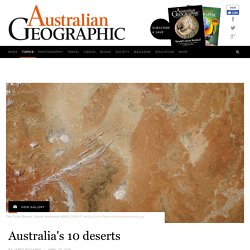
Seventy per cent of the mainland receives less than 500mm of rain annually, which classifies most of Australia as arid or semi-arid. While the Simpson and the Great Victoria deserts are the best known, Australia has a total of ten deserts. Defining a desert in Australia is complicated. Typically defined as areas receiving on average less than 250mm of rain per year, Australia’s deserts can sometimes technically exceed this average due to our uneven rainfall distribution. Forests. Forests are places with tall trees and a thick canopy.
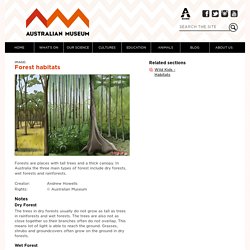
In Australia the three main types of forest include dry forests, wet forests and rainforests. Creator: Andrew Howells Rights: © Australian Museum Notes Dry Forest The trees in dry forests usually do not grow as tall as trees in rainforests and wet forests. Wet Forest Wet forests have very tall trees and they are usually found in areas where it rains a lot. Rainforest Rainforests have trees of all different heights growing close together. Grasslands. You are here Grasslands are dominated by perennial, mostly tufted or tussock-forming grasses and occur on the vast, undulating western volcanic plains, the northern alluvial plains and in Gippsland.
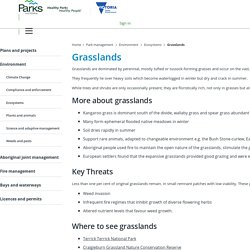
They frequently lie over heavy soils which become waterlogged in winter but dry and crack in summer. Wetlands. Wetlands. Woodlands. Woodlands. Alpine. There are many cute Australian alpine animals.

Alpine areas are not common in Australia, they cover only a tiny part, less than 0.15% of the continent, and are found in southern New South Wales, Eastern Victoria and central western Tasmania. Indigenous Connections. When we talk about learning to live in harmony with our environment it can be easy to forget that there are people in Australia who have been doing this for longer than most of us can imagine. Australia’s indigenous peoples have a huge amount of knowledge about our country and a strong connection to the land.
They also have a relationship with the environment that is incredibly sustainable. Classroom questions What do your students already know about the ways that indigenous people live and their relationship to our environment? Engage your students in a discussion about this issue using the following questions to guide your discussion (suggested answers included): Aboriginal Culture of the indigenous people of the Daintree. ‘Welcome to Kuku Yalanji country.

The area you are travelling through has great spiritual and cultural significance to our people’ (The above statement has been specifically been approved by local elders and was compiled by Mossman Gorge people for the Wet Tropics Management Authority) Altogether, there are 18 Rainforest Aboriginal tribal groups in the Wet Tropics World Heritage Area. In this area, the Traditional Owners are the Eastern Kuku Yalanji Aboriginal people. Their country extends from near Cooktown to Port Douglas. A rich array of plants and animals provided reliable food for the Eastern Kuku Yalanji people as they travelled seasonally throughout the area. Blue Mountains Australia Guide. Here are some interesting facts and statistics about Australia’s Blue Mountains: Fact: The Blue Mountains is a popular tourist destination receiving around three million day trippers each year.Fact: Domestic day trippers spend around $250 million per year in the area.Fact: The Blue Mountains is a great holiday destination for families and kids.

The Blue Mountains National Park spans across 267,954 hectares of land. This UNESCO (United Nations Educational, Scientific and Cultural Organization) World Heritage Site is comprised of over 140 kilometres of walking trails and tracks that lead to pristine scenery and picturesque views. The Blue Mountains’ most notable walking trails are paved throughout The Six Foot Track, Kanangra Walls to Katoomba, National Pass, Grand Canyon Walk, Blue Gum Forest and the Anderson Fire Trail. Greater Blue Mountains Drives – Fast Facts. Blue Mountains National Park.
Australian plants and animals. Australian brush turkey The Australian brush turkey, also known as bush or scrub turkey, can be found in rainforests along eastern NSW.
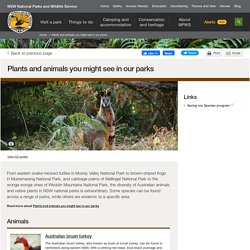
With a striking red head, blue-black plumage and booming call, these distinctive Australian birds are easy to spot while bird watching in several NSW national parks. Australian fur seal The largest fur seal, Australian fur seals are found in isolated rocky outcrops and islands along the NSW coast. They come ashore to form breeding colonies and can often be seen at Montague Island Nature Reserve. Blue Mountains City Tourism. Visit the Blue Mountains. Visitors to the Blue Mountains can experience history through diverse experiences — from prehistoric trees, Aboriginal culture and Jenolan Caves to convict-built roads, industrial age remnants and some of the most iconic man-made landmarks and attractions in the land including Scenic World, the Hydro Majestic and Carrington hotels.
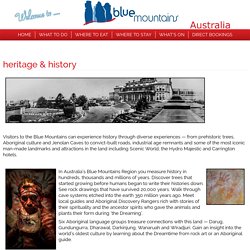
In Australia’s Blue Mountains Region you measure history in hundreds, thousands and millions of years. Discover trees that started growing before humans began to write their histories down. See rock drawings that have survived 20,000 years. Walk through cave systems etched into the earth 350 million years ago. Guide to The Three Sisters. Visit the Waradah Aboriginal Centre The Three Sisters watch over the land of the traditional country of the Darug, Gundungurra, Wiradjuri and Dharwal Aboriginal people.
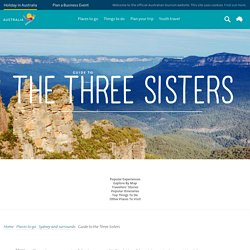
According to one Aboriginal legend, the pillars were once three beautiful sisters named Meehni, Wimlah and Gunnedoo who were turned into stone by a powerful tribal elder. Blue Mountains National Park. Explore the World Heritage-listed Blue Mountains National Park. Home of the famous Three Sisters, take a day trip from Sydney to the Blue Mountains area, near Katoomba. You'll discover Aboriginal culture, walking tracks, camping, canyoning, climbing and mountain biking activities. Blue Mountains National Park, one of the most well known parks in Australia, is part of the Greater Blue Mountains World Heritage Area. It's known for its remarkable geographic, botanic and cultural values, including protecting sites of Aboriginal cultural significance.
Blue Mountains History in Detail - Blue Mountains Australia. Sustainability explained through animation. The tomorrow book. Baiames Ngunnhu - the story of Brewarrina Fish Traps. NSW Holidays & Accommodation, Things to Do, Attractions and Events. Super Trawler: 18/09/2012, Behind the News. The second biggest fishing trawler in the world arrived in Australia last week. But with it came a sea of controversy. The Government has tried to stop the super trawler from dropping its huge nets in Australian waters.
But the company behind it says it's doing nothing wrong and has followed all the rules. So why has it become such a controversial issue? Let's take a look. NATHAN BAZLEY, REPORTER: Fans of fishing often say too much is never enough. They're talking about the age old pastime of chucking a line in though. It's been caught hook, line and sinker in a net of protest. The two types of fish it goes after are jack mackerel and red bait. Well it was planned to be used for actual fishing. Carbon Footprints. Ecological Footprint Calculator - WWF - WWF-Australia.
WWF is one of Australia’s most trusted conservation organisations. At WWF, we work in Australia and in our Asia-Pacific backyard to protect endangered species and habitats, meet the challenge of climate change, and build a world where people live in harmony with nature. This would not be possible without financial support from our community. Thank you! If you would like to help us, please make a donation. All donations of $2 or more to WWF-Australia are tax-deductible.
. © WWF-Australia 2018, All rights reserved. Shanghai climate: Average Temperature, weather by month, Shanghai weather averages - Climate-Data.org. Sydney climate: Average Temperature, weather by month, Sydney weather averages - Climate-Data.org. Australian Building Codes Board. China: climatic regions - Students. SafeShare.tv.